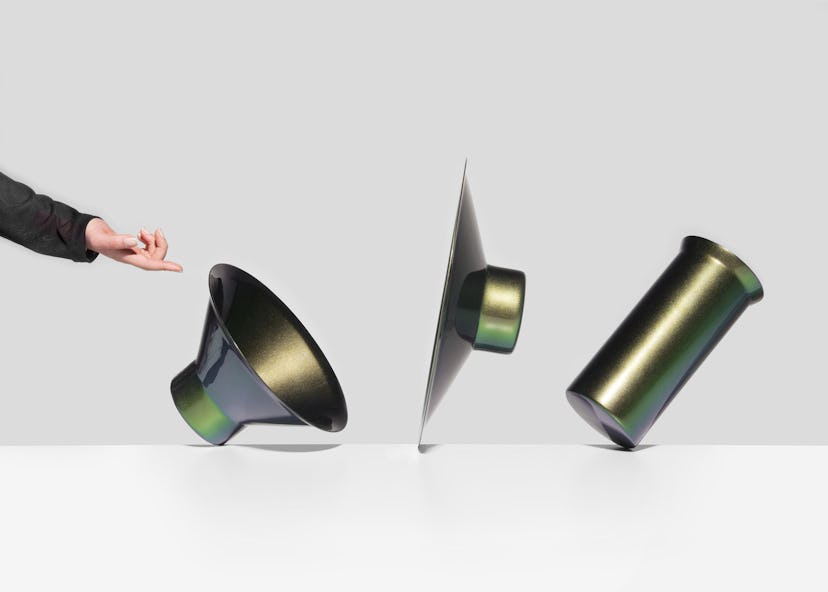More from Milan
Just as it’s impossible to see everything at the vast Milan furniture fair, there’s no way to take in all the exhibitions and installations that crop up concurrently in the city’s center. But it’s fun to try.

Prada’s women’s store on Via Montenapoleone displayed a group of Verner Panton’s elegant CloverLeaf sofas, covered in velvet in rich shades of green, red, and gold. These particular iterations of the sofa, however, are not for sale; they’ll be shown in select Prada stores.
On another note entirely, the designer Martino Gamper created “In a State of Repair,” a collaboration with the department store La Rinascente and London’s Serpentine Galleries that celebrated the idea of repair and restoration. In stalls outside the store, skilled craftspeople were available to repair things like shoes and bicycles, or re-cane chairs. Gamper, who says, “A lot of my work is about reinterpreting and mending things,” wanted to remind people that “there is a fixing industry.”
At the Museo Bagatti Valsecchi, Rossana Orlandi curated “Untold,” an exhibition organized with Vionnet and Audemars Piguet that featured works like JAMESPLUMB’s Cupboard Steps, the improbable union of a Georgian corner cupboard and a Medieval spiral stair; and Formafantasma’s “Still,” a collaboration with the Viennese crystal company Lobmeyr that explores water purification in engraved crystal and copper.
The Swiss school ECAL’s exhibition “Delirious Home” offered a cheeky, interactive satire of the smart house, which—the students contend—is still missing an object that is “able to laugh at itself.” The show was filled with smile-inducing designs like a curtain that was parted by a disembodied hand when you approached it, or a group of vessels that spun improbably on their edges.
The British designer Faye Toogood showed Roly-Poly, her new collection of fiberglass furniture whose chunky proportions and rounded contours are a departure from her earlier, angular work. Toogood also debuted Indigo Storm, a collection of creamware for 1882 Ltd., and a collection of coats that she designed with her sister, Erica Toogood.
Fabrica ‘s exhibition “Hot and Cold,” a collaboration with the air-conditioner manufacturer Daikin, explores the idea of temperature in designs ranging from tropical plants encased in ice (as the ice melts, parts of the plants start to emerge) to an acoustic composition based on the sounds made by Venus and Neptune, the hottest and coldest planets, respectively.
The Danish textile company Kvadrat invited designers—among them Lindsey Adelman, Big-Game, Max Lamb, and Philippe Nigro—to explore one of its best-known fabrics, Divina, a felt-like wool known for its range of colors. While most employed techniques like draping, stacking, or piecing, designer Jerszy Seymour took a chain saw to bolts of the fabric.
The fashion retailer COS teamed up with the Japanese design studio Nendo to create “COS x Nendo,” an installation in which COS’s white shirts take on various shades of gray as they pass through Nendo’s signature geometric structures.
But it was one of the week’s more modest installations that proved particularly satisfying. “Source Material,” a compact, personal exhibition curated by Jasper Morrison, Jonathan Olivares, and Marco Velardi, invited people in creative fields to send in a resonant or influential object. Among these were books, a sewing machine (Erwan Bouroullec), the album cover of Orchestral Manoeuvres in the Dark’s “Architecture and Morality,” (Mike Meiré), and a whimsical stone with a tiny red, blinking LED embedded in its surface (Yves Marbrier).
Photos: More from Milan
Verner Panton’s CloverLeaf sofas, covered in richly-colored velvet, were on view at Prada’s Via Montenapoleone women’s store.
Martino Gamper’s installation “In a State of Repair” featured stalls in front of La Rinascente where people could have things like shoes, toys, and bicycles repaired by skilled artisans.
JAMESPLUMB’s Cupboard Steps were featured in “Untold,” an exhibition curated by Rossana Orlandi at the Museo Bagatti Valsecchi.
Formafantasman’s installation “Still,” a collaboration with the Austrian crystal manufacturer Lobmeyr, was also featured in “Untold.”
“Ostinati,” designed by the ECAL students Iris Andreadis, Nicolas Nahornyi, and Jérôme Rütsche, was part of the exhibition “Delirious Home.”
Photo: ECAL/Axel Crettenand & Sylvain Aebischer.
A chair from Faye Toogood’s Roly-Poly collection of fiberglass furniture.
“Hot & Cold,” an exhibition organized by Fabrica, featured explorations of the idea of temperature, like “Flora,” a series of (artificial) tropical plants that are encased in ice—at least until the ice begins to melt.
Kvadrat invited designers to explore the properties of its felt-like wool textile Divina; the French designer Philippe Nigro created his “Lasagna” daybed by stacking and folding layers of the fabric. Photo: Casper Sejersen.
The retailer COS and the Japanese design studio Nendo collaborated on “COS x Nendo,” an installation in which Nendo’s signature geometric shapes “transformed” Cos’s shirts from white to various shades of gray.
The exhibition “Source Material” gathered resonant objects from various creatives, including a sewing machine (Erwan Bouroullec), a roll of friction tape (Naoto Fukasawa), and a rock with an embedded red LED (Yves Marbrier). Photo: Daniele Ansidei.